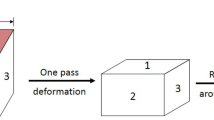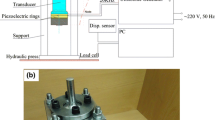Abstract
In the ultrasonic-assisted metal forming process, the dislocations within the material are easier to move due to the absorption of ultrasonic energy, which can effectively promote material flow and improve the formability of components; this phenomenon is called the ultrasonic softening effect. The ultrasonic softening effect is generally treated as homogeneous at the whole materials for simplicity, while the attenuation of the ultrasonic energy along the propagation direction will bring inhomogeneous distribution of softening degree. In addition, the absorption of the ultrasonic energy by the material is also affected by the dislocation movements in the metal plastic processing procedure, resulting in the variation of the ultrasonic attenuation characteristics in the material with the plastic deformation, and the current research has little concerned about it. In this paper, the ultrasonic attenuation properties in 2219-O aluminum alloy with plastic strain were investigated. The influence of the dislocations and the dislocation movements caused by plastic deformation on the ultrasonic attenuation was characterized. The pre-strain specimen was designed to indicate the degree of plastic deformation of the material, and the specimen thickness direction was defined as the propagation direction of the ultrasonic energy. The experimental results and the microstructure observation showed that the absorption of ultrasonic energy by the material increases firstly and then decreases with the plastic strain increasing, which is related to the evolution of movable dislocations within the material. In order to accurately describe the ultrasonic energy attenuation characteristics in plastic deformation, the hardening equation of 2219-O aluminum alloy considering ultrasonic propagation distance and plastic strain was built, and the model accuracy was verified based on the experimental data.















Similar content being viewed by others
Data availability
Not applicable.
Code availability
Not applicable.
References
Huang JC, Tsai YC, Huang C (2007) Frictional effect of ultrasonic-vibration on upsetting. Ultrasonics 46:277–284. https://doi.org/10.1016/j.ultras.2007.03.003
Gallego-Juárez JA, Graff KF (2014) Power ultrasonics: applications of high-intensity ultrasound. Woodhead Publishing
Hung JC, Lin CC (2013) Investigations on the material property changes of ultrasonic-vibration assisted aluminum alloy upsetting. Mater Des 45:412–420. https://doi.org/10.1016/j.matdes.2012.07.021
Khan A, Giraud-Audine C, Bigot R, Abba G, Abideen MZ (2016) An alternative explanation of forming force reduction for forming process submitted to vibration: influence of the waveform in the viscoplastic domain. J Mater Process Technol 230:288–299. https://doi.org/10.1016/j.jmatprotec.2015.11.019
Wang CJ, Liu Y, Guo B, Shan DB, Zhang B (2016) Acoustic softening and stress superposition in ultrasonic vibration assisted uniaxial tension of copper foil: experiments and modeling. Mater Des 112:246–253. https://doi.org/10.1016/j.matdes.2016.09.042
Siddiq A, Sayed TE (2011) Acoustic softening in metals during ultrasonic assisted deformation via CP-FEM. Mater Lett 65:356–359. https://doi.org/10.1016/j.matlet.2010.10.031
Wang CJ, Liu Y, Zhang B (2017) Development of ultrasonic vibration assisted uniaxial tension device and utilization in evaluation of micro tension deformation behavior of copper foil. Ferroelectrics 521:53–60. https://doi.org/10.1080/00150193.2017.1391018
Yang CQ, Shan XB, Xie T (2016) Titanium wire drawing with longitudinal-torsional composite ultrasonic vibration. Int J Adv Manuf Technol 83:645–655
Han G, Wan W, Zhang Z (2021) Experimental investigation into effects of different ultrasonic vibration modes in micro-extrusion process. J Manuf Process 67:427–437. https://doi.org/10.1007/s00170-015-7540-1
Vahdati M, Mahdavinejad R, Amini S (2015) Investigation of the ultrasonic vibration effect in incremental sheet metal forming process. Proc Institution Mech Engineers Part B: J Eng Manuf 231:1-12. https://doi.org/10.1177/09544054155785
Siddiq A, Sayed TE (2012) A thermomechanical crystal plasticity constitutive model for ultrasonic consolidation. Comput Mater Sci 51:241–251. https://doi.org/10.1016/j.commatsci.2011.07.023
Yao ZH, Kim GY, Wang ZH (2012) Acoustic softening and residual hardening in aluminum: modeling and experiments. Int J Plast 39:75–87. https://doi.org/10.1016/j.ijplas.2012.06.003
Wang XW, Wang CJ, Liu Y (2021) An energy based modeling for the acoustic softening effect on the Hall-Petch behavior of pure titanium in ultrasonic vibration assisted micro-tension. Int J Plast 136:102879. https://doi.org/10.1016/j.ijplas.2020.102879
Feng R (1999) Ultrasonics handbook. Nanjing University Press, Nanjing, China
Shi L, Wu CS, Padhy GK (2016) Numerical simulation of ultrasonic field and its acoustoplastic influence on friction stir welding. Mater Des 104:102–115. https://doi.org/10.1016/j.matdes.2016.05.001
Cui JH, Zhao YX, Li XK, Yu ZQ, Li SL (2021) Research on the influence of ultrasonic on the inner rib’s surface morphology of ribbed cylindrical parts in flow spinning process. J Manuf Process 67:376–387. https://doi.org/10.1016/j.jmapro.2021.04.071
Gan T, Yu ZQ, Zhao YX, Fan XG, Lai XM (2020) A continuous dynamic recrystallization constitutive model combined with grain fragmentation and subgrain rotation for aluminum alloy 2219 under hot deformation. Modell Simul Mater Sci Eng 29:025002. https://doi.org/10.1088/1361-651X/abcd8a
Zhu L, Liu XB, Fan P, Liu JQ (2019) A study of microstructure evolution during creep of 9Cr-1Mo steel using ultrasonic and hardness measurements. J Mater Eng Perform 28:2348–2355. https://doi.org/10.1007/s11665-019-03987-3
Roters F, Raabe D, Gottstein G (2000) Work hardening in heterogeneous alloys—a microstructural approach based on three internal state variables. Acta Mater 48:4181–4189. https://doi.org/10.1016/S1359-6454(00)00289-5
Kenderian S, Berndt TP, Green RE Jr, Djordjevic BB (2003) Ultrasonic monitoring of dislocations during fatigue of pearlitic rail steel. Mater Sci Eng: A 348:90–99. https://doi.org/10.1016/S0921-5093(02)00636-6
Funding
This work was supported by the National Key Research and Development Program of China (Grant Number 2020YFA0711102) and the National Natural Science Foundation of China (Grant Numbers 51875352, 51790175).
Author information
Authors and Affiliations
Corresponding author
Ethics declarations
Ethical approval
I certify that the paper follows the guidelines stated in the journal’s “Ethical Responsibilities of Authors.”
Consent to participate
Not applicable.
Consent for publication
Yes.
Competing interests
The authors declare no competing interests.
Additional information
Publisher's note
Springer Nature remains neutral with regard to jurisdictional claims in published maps and institutional affiliations.
Rights and permissions
Springer Nature or its licensor (e.g. a society or other partner) holds exclusive rights to this article under a publishing agreement with the author(s) or other rightsholder(s); author self-archiving of the accepted manuscript version of this article is solely governed by the terms of such publishing agreement and applicable law.
About this article
Cite this article
Li, S., Zhao, Y., Cui, J. et al. Ultrasonic energy attenuation characteristics in plastic deformation of 2219-O aluminum alloy. Int J Adv Manuf Technol 125, 267–278 (2023). https://doi.org/10.1007/s00170-022-10715-0
Received:
Accepted:
Published:
Issue Date:
DOI: https://doi.org/10.1007/s00170-022-10715-0




